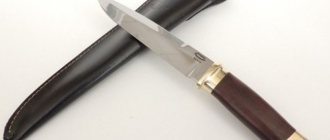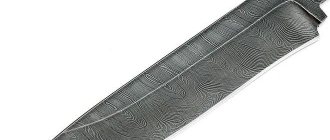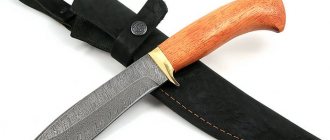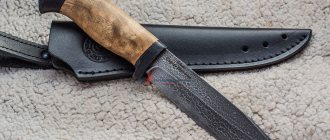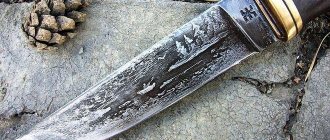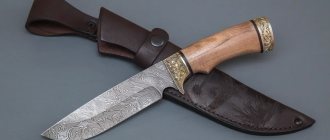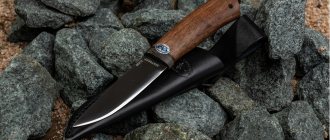What kind of steel is this
Damascus steel is a set of several hundred alternating layers of hard and soft steel. During the forging process, they are stretched, twisted and reforged many times.
The result is a material with a characteristic linear pattern, which is ideal for making knives.
The history of the creation of the material goes back to the distant past. At that time, blades made from it were considered one of the best of their kind and were very expensive. There are many interpretations of the origin of its name. Among them, the most plausible are:
- according to one version, the name comes from the city of Damascus, where it was first found by archaeologists;
- according to another, it was first made by the blacksmith Damascus, in whose honor it received its name;
- The word "Damascus" means "water" in Arabic. In the manuscripts of that time it was described as a blade, the surface of which repeats the pattern of the water surface.
Chemical composition
Due to the manufacturing characteristics, it is not homogeneous. The composition includes both stainless steel grades with a high chromium content and low-alloy ones.
The norms and quantitative content of alloying components of Damascus steel are not regulated by any domestic or foreign standard. It is produced differently in each workshop, so the content of chromium and other metals in each blade is different. As a rule, the quantitative carbon content in it does not exceed 2%.
The amount of other alloying components depends on the set of components from which it was made.
For example, for manufacturing, blacksmiths can use the set of steels presented in the table.
| Name | Alloying component | Mass fraction in metal, % | Purpose |
| X12MF | WITH | 1,45 – 1,65 | Carbon gives the alloy hardness and increases wear resistance. |
| Cr | 11,0 – 12,5 | Increases the metal's resistance to corrosion and improves its wear resistance. | |
| V | 0,4 – 0,6 | The use of vanadium improves hardness and extends its service life. | |
| Ni | 0,15 – 0,3 | Alloying the metal with nickel increased its strength and corrosion resistance. | |
| 40Х13 | C | 0,36 – 0,45 | Gives the metal hardness and makes it more resistant to wear. |
| Cr | 11,0 – 12,5 | Chromium prevents local corrosion of the alloy. |
How does damask differ from damascus?
“I’ll buy everything,” said gold. “I’ll take everything,” said the damask steel.
Surely you have come across both terms - damask steel and damask. But perhaps you don't yet have a clear idea of what makes one "patterned steel" different from another.
Understanding the terminology
In general, everything here is not as difficult as it might seem. What these materials have in common is the presence of a pattern, but their manufacturing technologies differ radically.
The legendary Indian damask steel is, unfortunately, a lost technology: it was once passed down orally and was so carefully hidden that it was completely lost several centuries ago.
The production of damask steel was not cheap, and already in the 17th century, affordable and sufficiently high-quality industrial steel began to appear, so the demand for damask steel fell and then completely disappeared.
Everything we know about it (partly thanks to history, partly thanks to the experiments of the Russian metallurgist Pavel Petrovich Anosov) fits into a couple of phrases - damask steel was exceptionally strong, sharp and, of course, legendaryly beautiful. In Rus', damask steel was often called kharalug (horolug), or kharaluzhnaya (horoluzhnaya) * steel, although in fairy tales we often encounter the term “damask steel” itself.
* You can find one or the other spelling. Perhaps the option taken out of brackets would be more correct, since, firstly, it is precisely this one that is found in ancient sources, in the same “Tale of Igor’s Campaign”, and secondly, it preserves the letter “a” in the common Turkic root “hara” /“kara” (“black”).
By the way, about fairy tales and epics. They attribute almost magical properties to damask blades, but it is wrong to think that this is some kind of non-existent, fairy-tale metal. In fact, damask steel was simply the best option for its time.
Practical tests of even the best samples that have survived to this day show properties close to ordinary inexpensive carbon steels of modern manufacture. However, in the Middle Ages, the bulk of blades were made from such low-quality raw materials that even such properties seemed mystical and magical to contemporaries.
At one time, Anosov, in the first half of the 19th century, managed to create an alloy that fully met all the characteristics of damask steel. Although, of course, we cannot know for sure how similar the technology and composition discovered by our metallurgist are to the “original”.
The fact is that there were several technologies for producing damask steel even in ancient times: it is not known for certain whether Anosov recreated one of them or came up with his own.
The damask steel blade of the Turkish saber is what we call historical damask steel
And now we come to the actual clarification. Historically, there were two main technologies for producing patterned steel. One of them involved casting, the other involved welding and forging several types of steels together; the first retained the name damask steel, and the second began to be called damask.
So:
- Cast damask steel is patterned steel in the historical sense we are familiar with, produced by casting and forging methods.
- Welded damask steel (or Damascus) is patterned steel produced primarily by forging methods.
High-quality weapons were made from special “damask steel” ingots called wootz. It was the beauty of the damask pattern that was associated with its magnificent properties.
But wootz was expensive and difficult to produce, which spurred the search for technologies for creating patterned blades by alternative means. What is now called Damascus began to be produced specially, by folding and forging several layers of blanks from different types of steel.
The new material was not inferior in strength to damask steel, and in appearance it turned out to be much more beautiful than cast damask steel.
Now, a little more about the types of damask steel and types of damascus - we will make this division because we classify materials according to different principles: regarding damask steel, we will talk about the alloying elements in its composition, and regarding damascus, we will also talk about several technologies.
Types of cast damask steel: high-carbon and stainless alloys
One more important note about damask and damask that is worth making right now.
In their chemical composition, they most closely resemble the high-carbon steels we are used to, but with a very heterogeneous composition, and this means both increased strength and toughness, and susceptibility to rust.
Carbon and stainless steel, as we know, are not just two steels with different compositions. The difference is rather vague - the whole point is whether the material contains alloying elements that increase the corrosion resistance of steel, and in what quantity.
So, normally damask steel corresponds to what we call carbon steel, but a modified chemical composition (adding a significant amount of chromium - from 14% or more) while maintaining the physical structure gives us the so-called stainless damask steel. It retains the properties of strength and hardness inherent in ordinary cast damask steel, and products made from it are almost as easy to sharpen. But a product made from it, like any hand-forged product, is incredibly expensive.
On the left is ordinary cast damask steel with a high carbon content; on the right - a stainless steel composition with conventional damask steel casting technology
Eight types of welded damask steel (damascus)
With Damascus, everything is much more interesting: there are at least eight varieties of welded damask steel, also known as Damascus. Before we get to them, it's worth making a quick note.
In principle, it is possible to create stainless Damascus. To do this, you need to assemble a package of steel alloyed with the necessary additives and start welding it in a vacuum, laying it in layers and unforging it, and then repeating this cycle again. Technically, this is quite difficult, but modern technologies successfully cope with the task, as exemplified by chef’s knives with patterned stainless steel linings.
Kanetsugu kitchen knife from the Tojiro range with patterned steel handles
"Wild" Damascus
This is the same damask that is obtained if the master does not use special tools and technologies, that is, if the process occurs naturally.
Sheets of steel with different chemical compositions are folded together, welded and unforged; then they are cut in half, folded again, and all actions are repeated. The result is layered steel.
If its forging does not have a clear plan, then the pattern turns out disordered, or “wild”.
“Wild” and simple damask are two subtypes of the technique, which has no characteristic features, but is the usual overlay of layers on top of each other, followed by free-style forging
Stamp Damascus
When making this type of patterned steel, the blacksmith uses a tool called a stamp: thanks to it, a beautiful pattern appears on the surface of the layered Damascus plate, not very reminiscent of the pattern on plain Damascus. Depending on the stamp's pattern, it may resemble a ladder, the growth layers of a tree cut, the surface of water in the rain, or a combination of these patterns.
Stamp Damascus is produced using a special tool - a stamp.
Mosaic Damascus
Mosaic damasks are often distinguished not only by the technology of forging, but also by the composition itself - the package is assembled in the manner of a mosaic from steel blanks of different shapes and compositions so that as a result of overlaying and forging, such a characteristic pattern is obtained.
The mosaic on the surface of this type of Damascus is the “merit” not of technology, but of the correct selection of steel package
Mosaic Powder Damascus
One of the most difficult types of damask; a technology that is rarely practiced in Russia.
To create a blade like the one in the photo, you need to prepare a cliche with a certain slotted pattern made of steel.
Then the cliche is filled with powdered steel, which, when etched, will contrast with the base, and under the influence of high temperatures and pressure it turns into a monolith.
Now from this ingot it is possible to forge a blade using conventional technology, welding or alternating patterned layers with each other.
Powder mosaic damascus is a rare phenomenon in Russia
Twisted Damascus
Twisted Damascus, also known as Turkish, is created by twisting a piece of several welded rods around itself.
The pattern will depend on the number and composition of steels in the original package, the angle of twist and the depth of the cut.
As with mosaic technology, from the resulting “twist” you can then unforge a blade using conventional technology, welding or alternating patterned layers with each other.
Twisted Damascus (aka Turkish) gets a characteristic pattern when the blacksmith twists the workpiece several times during the forging process
Mosaic end damascus
The technique for making this type of damascus is somewhat different from others. A patterned mosaic of parts of various shapes and different steels is applied to a blade made of homogeneous steel.
Then the workpiece is boiled under a vacuum press. Thus, no folding or torsion is used in its manufacture.
When a fully forged block is ready, the plates that previously served as the basis for assembling the mosaic are cut off from it.
The side covers of such damascus are sections from a finished forged block
Fiber Damascus
Another foreign method of forging Damascus. Its composition is no different from the standard one, and neither is the beginning of unchaining. But about halfway through the process, the blacksmith turns the workpiece 90 degrees and begins to unforge it again. This is how characteristic “short” (compared to ordinary) divorces are obtained.
The short “fibers” of this type of damascus are the result of a special technique where the blacksmith turns a half-forged piece and starts all over again.
Multi-row Damascus
This is a view, rather, not of a material, but of a finished product, that is, a blade. Damascus strips of different designs (mosaic, twisted, etc.)
) are placed side by side and forged together in order to create a visually impressive combination of patterns.
The composition and manufacturing technique of these strips often differ: closer to the cutting edge, a durable and sharp type of damascus is placed, and closer to the butt, a durable and tough type with especially beautiful patterns is placed.
It is more correct to call the blade itself multi-row, not Damascus
A little about the manufacturing technologies of damask steel and damascus
There is no ready-made, only correct “recipe” for a package of steel for the production of cast damask steel and welded damascus, and many patterned steels assembled using casting and forging technologies can bear this name. However, damask alloys still have several characteristic features.
This is, perhaps, the minimum thing that anyone who is planning to purchase a damask (cast or welded) blade needs to know.
What's good: pros and cons
Damascus steel, like any other metal, has its advantages and disadvantages. For greater clarity, they have all been collected in a single table presented below.
| Advantages | Flaws |
| Durability . Thanks to the use of high-alloy steel grades, the blades have high strength indicators and hold the factory sharpening for a long time. | Poor corrosion resistance . Since there are practically no individual alloying elements in its composition, it has poor resistance to corrosion. |
| Flexibility . The use of low-carbon steels made it possible to produce blades with exceptional flexibility. | High price . The complex manufacturing and hardening procedure, as well as the presence of several types of metal in the composition, increase the cost of the finished blade. |
| Long service life . The optimal combination of metals with different characteristics made it possible to increase the service life of blades. | |
| Wear resistance . The use of high-alloy metals and optimal hardening made it possible to increase the wear resistance of blades. | |
| Aesthetic appearance. Features of the manufacturing process give the blade a special texture, similar to the pattern on the surface of water. |
We recommend reading an interesting article about the 12 best steels for making a knife today.
Analogs
The only grade of steel that has similar characteristics to Damascus is damask steel. It has exceptional strength and toughness. Damask steel blades are resistant to impacts, bends and hold the factory sharpening for a long time.
Their hardness reaches 64 units on the Rockwell scale.
Damask steel blade is an alloy of iron and carbon with a low content of alloying elements. A special technology of melting and hardening, combined with a high-tech forging process, gives it a dark, almost black color. In addition, it has a fibrous pattern, which gives it a similarity to Damascus steel products.
The best manufacturers
Despite the difficulty of manufacturing and hardening, Damascus steel blades are made all over the world. Each manufacturer uses a certain set of materials for this, mixing them in a certain proportion. Based on user reviews and expert opinions, the best domestic knife manufacturers are the following companies:
- Vorsma;
- Chrysostom;
- Kizlyar Supreme.
There are also many Damascus steel knives on the world market. The following companies produce the highest quality:
- Boker;
- Hezhen;
- Sunnecko.
Storage
Whether it be hunting knives made of Damascus steel or kitchen products, it is recommended to store them clean in a dry place, preferably in a special sheath or holster. If you have to store a knife in conditions of high humidity, it is better to periodically coat its blade with oil. Vaseline can be effective for this purpose.
Some hunters store Damascus knives in a holster soaked in regular vegetable or special weapon oil. For long-term storage without the need for regular use, it is better to remove the product from its sheath.
Review of the NKVD knife
A universal knife of a high price category. The blade, made of Damascus steel, has excellent hardness and strength. The classic blade design makes it easy to use.
The guard and pommel are made of cast cupronickel alloy and polished to a mirror shine. To make the handle, bog hornbeam was used.
The ergonomic shape of the handle ensures a reliable grip and retention of the knife in the hand, and the size and shape of the guard effectively protect the user’s hand from accidental injuries.
Specifications:
- blade material – Damascus steel;
- handle material – cupronickel with a stained hornbeam overlay;
- hardness, HRC units – 60 -61;
- knife length, mm – 235;
- blade length, mm – 125.
Kitchen knife from the findking brand
We can talk about this knife for a long time, but the advantage of the model is obvious: its excellent appearance, quality of materials and workmanship. This model is a high-class knife, manufactured using the most modern and advanced equipment in China. This model is so beautiful and elegant that I decided to order it myself. If anyone already has such a knife, please unsubscribe in the comments and leave a review.
Review of the Yakut knife
A mid-priced hunting knife. The simple-looking blade, made of Damascus steel, has good hardness and flexibility. The blade holds a cutting edge for a long time and is easy to sharpen. Despite the average size of the blade, it is convenient for cutting meat, branches and other materials.
A simple wenge stained wood handle ensures a secure grip. Impregnation of wood with a special composition made it less susceptible to harsh operating conditions. The absence of a guard makes the knife more convenient to use.
A nice addition will be a wooden sheath that protects the blade from mechanical damage.
Specifications:
- blade material – Damascus steel;
- handle material – wood;
- hardness, HRC units – 60 -61;
- knife length, mm – 275;
- blade length, mm – 150.
Damascus steel, despite its high cost, is one of the most popular grades. It has good hardness and cutting edge sharpness. We hope that after reading the article, everyone will be able to decide whether they need a knife made of this steel or not, and which one is better to choose. If you have already purchased such a blade, write down your impressions of its use. Your experience will be useful to other users.
Damascus steel kitchen knife FZIZUO 7.5 »
FZIZUO 7.5" is a large kitchen knife. Such models are also called chef knives. In fact, this model is not just a tool for cutting food in the kitchen, but a decoration for this sacred place for many. This knife is made by hand. The core is a package of VG10 steel. The outer layers are made of softer steels. This technology allows the knife to remain sharp for a long time and at the same time this model is able to withstand heavy loads and has high viscosity.
